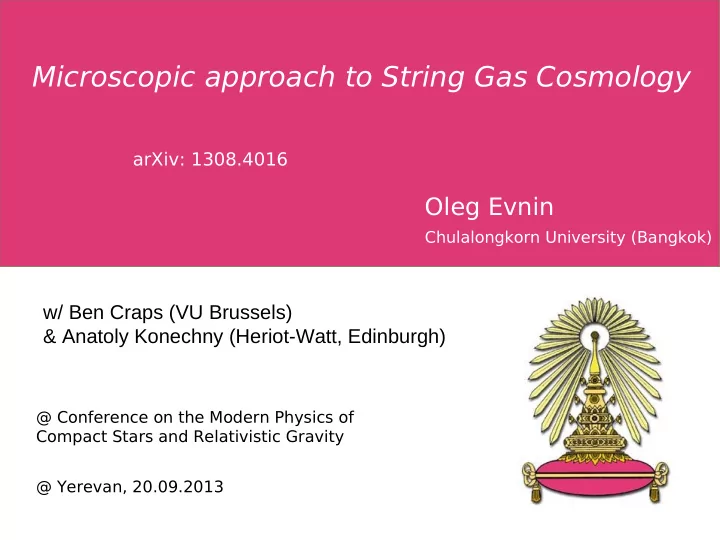

Microscopic approach to String Gas Cosmology arXiv: 1308.4016 Oleg Evnin Chulalongkorn University (Bangkok) w/ Ben Craps (VU Brussels) & Anatoly Konechny (Heriot-Watt, Edinburgh) @ Conference on the Modern Physics of Compact Stars and Relativistic Gravity @ Yerevan, 20.09.2013
Gravity quantization 1) The presence of singularities and highly curved near-singular regions in classical Einstein's gravity necessitates the development of a quantum gravity theory (in particular, in relation to early cosmology problems). 2) The problem has evaded a complete solution for many decades, despite the considerable effort on the part of the theoretical physics community. 3) Tangible results are far between and rather limited in nature. 4) For example, conventional perturbative string theory provides an S-matrix for scattering of quantized gravitons in flat space-time (though saying little about the physically interesting more dynamical situations). Oleg Evnin (Chula U.) Yerevan gravity etc. 2013-9-20 p. 2
Perturbative string theory 1) One quantizes relativistic massless strings moving in a flat background space-time and discovers that the excitation spectrum includes massless spin-2 particles (gravitons) that can be used to describe geometrical deformations of the background (=linearized gravity). 2) One computes the S-matrix for scattering such excitations and discovers that it agrees in the low-energy limit with the standard gravitational scattering. 3) One proclaims that one has quantized gravity in a flat space-time background. 4) The theory has 2 scales: the usual Planck mass, and the so-called “string scale” governing the fluctuations of the strings. Their ratio g s is small in the perturbative regime and provides an expansion parameter. Oleg Evnin (Chula U.) Yerevan gravity etc. 2013-9-20 p. 3
Perturbative string theory S-matrix is computed using path integrals over worldsheets. Higher topologies are weighted by higher powers of the string coupling g s . (As for any S-matrix computation) asymptotic regions are required. Oleg Evnin (Chula U.) Yerevan gravity etc. 2013-9-20 p. 4
Strings in a compact space? • Consider strings in a compact space, for concreteness torus. • No asymptotic regions no S-matrix. • Can we compute how strings interact in such a space? • Infrared divergences invalidate conventional string perturbation theory. Goal: propose natural observables and argue that IR divergences are generically absent (and otherwise well-understood). Oleg Evnin (Chula U.) Yerevan gravity etc. 2013-9-20 p. 5
IR-divergences: analogies The IR-divergences one discovers are intimately linked to the gravitational backreaction of strings on the background space (finite energy density from even 1 string quantum!) The backreaction is not classical, since the strings are not classical. Similar divergences occur in problems of D0-brane recoil in string theory and soliton recoil in field theory. The general intuition is that one should reorganize the perturbation theory in such a way that the modes responsible for divergences appear as explicit integration variables in the path integral (“collective coordinate method”). Oleg Evnin (Chula U.) Yerevan gravity etc. 2013-9-20 p. 6
Quantizing the uniform modes Explicitly quantize the spatially uniform modes: Gauge choice: constant, . These are the degrees of freedom of minisuperspace models, which are often considered in quantum cosmology. Oleg Evnin (Chula U.) Yerevan gravity etc. 2013-9-20 p. 7
Minisuperspace models • Time reparametrization invariance Hamiltonian constraint. • Define amplitudes for universe to have spatial sections and . Integrate over the duration of the transition: • We will quantize the string zero modes in a similar way. But how to turn this into a string amplitude? Oleg Evnin (Chula U.) Yerevan gravity etc. 2013-9-20 p. 8
Worldsheets in dynamical backgrounds Amplitudes for strings in compact cosmological spaces: G(t) is the background “minisuperspace” metric S X is the usual “area” action for string worldsheets (in a curved target space) S ms is the gravity action constrained to minisuperspace configurations Oleg Evnin (Chula U.) Yerevan gravity etc. 2013-9-20 p. 9
Amplitude properties 1) Divergent terms disappear after the integral over background space-times has been included. (Cancellation between worldsheets of different topologies = the Fischler-Susskind mechanism.) 2) Strings backreact on the geometry, most obviously through contributions of the worldsheet action to the amplitude (plus more elaborate perturbative corrections). 3) Note that in these models, the higher Kaluza-Klein modes are represented by states of the strings (as they are in the usual perturbative string theory S-matrix), whereas the Kaluza-Klein zero modes appears explicitly in the space-time language. Oleg Evnin (Chula U.) Yerevan gravity etc. 2013-9-20 p. 10
String gas cosmology • Interesting conjectural phenomenology, but few established results • Gas of strings with winding modes (p<0) and momentum modes (p>0), initially in quasi-static phase (p=0). • The expansion of different dimensions is strongly affected by the winding strings and how they backreact. • Only 3 dimensions expand? (Kinematics of stretched string scattering.) • Possible alternatives to inflation? • Usually analyzed in a thermodynamical context, though the number of string quanta is not large → microscopic approach? Oleg Evnin (Chula U.) Yerevan gravity etc. 2013-9-20 p. 11
Summary • A number of interesting phenomenological conjectures have been made for compact cosmological spaces filled with relativistic quantum string gases. • Conventional string perturbation theory is ill-defined in this context, due to infrared divergences associated with substantial backreaction from a finite number of string quanta. • We have constructed a modified string perturbation theory, modelled on the field-theoretical treatment of the soliton recoil problem and including an explicit path integral over a class of backgrounds (“collective coordinate method”). The infrared issues are resolved in this context. • It would be interesting to re-investigate the phenomenology in our set-up............ Oleg Evnin (Chula U.) Yerevan gravity etc. 2013-9-20 p. 12
Recommend
More recommend